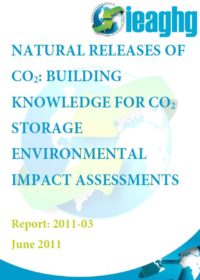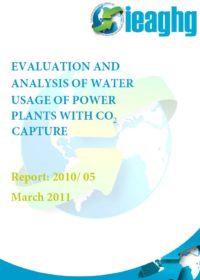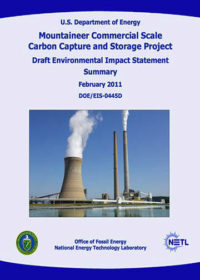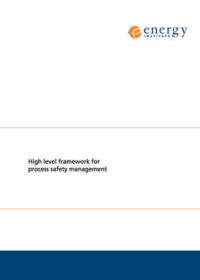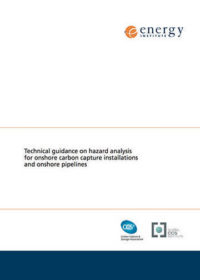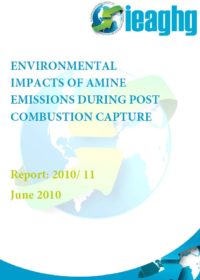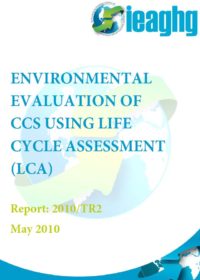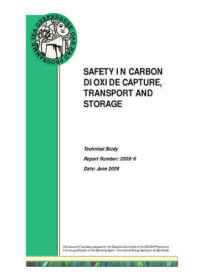Resources
Publications
Our publications, reports and research library hosts over 500 specialist reports and research papers on all topics associated with CCS.
View our Publication Library Disclaimer.
Filter by
Natural releases of CO2: building knowledge for CO2 storage environmental impact assessments
6th June 2011
Topic(s): Carbon capture use and storage (CCUS), CO2 storage, Health safety and environment
The IEAGHG workshop on Natural Releases of CO2: Building Knowledge for CO2 Storage Environmental Impact Assessments was held in Maria Laach, Germany, in November 2010 and hosted by CO2GeoNet and BGR. The workshop was well attended, with forty seven participants from over ten different countries.
This highly productive and informative workshop expresses the importance of such meeting at a time when despite emerged CCS regulations requiring Environmental Impact Assessments uncertainties remain and the research community are asked to advance understanding.
Disclaimer
The content within the Global CCS Institute Publications, Reports and Research Library is provided for information purposes only. We make every effort and take reasonable care to keep the content of this section up-to-date and error-free. However, we make no claim as to its accuracy, currency or reliability.
Content and material featured within this section of our website includes reports and research published by third parties. The content and material may include opinions and recommendations of third parties that do not reflect those held by the Global CCS Institute.
Evaluation and analysis of water usage of power plants with CO2 capture
22nd March 2011
Topic(s): Carbon capture use and storage (CCUS), CO2 capture, Health safety and environment
The primary purpose of this study is a review of the current state of the art technology in reducing water consumption for any coal or gas fired power generation technologies.
Disclaimer
The content within the Global CCS Institute Publications, Reports and Research Library is provided for information purposes only. We make every effort and take reasonable care to keep the content of this section up-to-date and error-free. However, we make no claim as to its accuracy, currency or reliability.
Content and material featured within this section of our website includes reports and research published by third parties. The content and material may include opinions and recommendations of third parties that do not reflect those held by the Global CCS Institute.
Mountaineer commercial scale carbon capture and storage project: draft environmental impact statement summary
1st February 2011
Topic(s): Carbon capture use and storage (CCUS), Health safety and environment
This Draft Environmental Impact Statement (EIS) provides information about the potential environmental impacts of the proposed Mountaineer Commercial Scale Carbon Capture and Storage Project which would use a chilled ammonia process (CAP) technology to capture approximately 90 percent of the CO2 from a 235-megawatt portion of AEP’s existing 1,300-MW Mountaineer Plant flue gas exhaust.
Disclaimer
The content within the Global CCS Institute Publications, Reports and Research Library is provided for information purposes only. We make every effort and take reasonable care to keep the content of this section up-to-date and error-free. However, we make no claim as to its accuracy, currency or reliability.
Content and material featured within this section of our website includes reports and research published by third parties. The content and material may include opinions and recommendations of third parties that do not reflect those held by the Global CCS Institute.
High level framework for process safety management
1st December 2010
Topic(s): Engineering and project delivery, Health safety and environment
Process safety management (PSM) is a major issue for the energy industry, with many organisations looking to adopt a more holistic and systematic approach to assuring the integrity of their operations.
The Energy Institute (EI) Process Safety Committee (PSC) identified a benefit in promoting a common high-level framework for PSM across the energy industry sectors. EI High level framework for process safety management ('PSM Framework') provides a simple and systematic approach suitable for organisations large and small across the energy industry sectors, defining the key things organisations need to get right in order to assure the integrity of their operations incorporating technical, maintenance, operational, and human and organisational factors.
Disclaimer
The content within the Global CCS Institute Publications, Reports and Research Library is provided for information purposes only. We make every effort and take reasonable care to keep the content of this section up-to-date and error-free. However, we make no claim as to its accuracy, currency or reliability.
Content and material featured within this section of our website includes reports and research published by third parties. The content and material may include opinions and recommendations of third parties that do not reflect those held by the Global CCS Institute.
Technical guidance on hazard analysis for onshore carbon capture installations and onshore pipelines
1st September 2010
Topic(s): Carbon capture use and storage (CCUS), CO2 hubs, CO2 transport, Health safety and environment
This document sets out the methodology for implementing appropriate hazard analysis for carbon dioxide related hazards on onshore carbon capture installations and pipelines. Users will be able to review potential projects and assess the hazards and likely frequency of those hazards through the appropriate use of frequency data. Project engineers will them be able to understand the consequences of any loss of carbon dioxide containment by modelling the dispersion of the carbon dioxide. These concentrations, when combined with the HSE’s parameters for occupational exposure to carbon dioxide indicate the likely level of harm arising from an intentional or accidental release of carbon dioxide. The document includes:
- hazard and risk analysis for carbon dioxide systems onshore;
- failure frequency data sources for carbon dioxide;
- detailed guidance on using currently available commercial dispersion models for carbon dioxide;
- fatal area predictions using SLOT/SLOD data and dispersion modelling; and
- gaps and uncertainties in carbon dioxide hazard analysis.
It is an essential new guide for modellers, engineers and health & safety specialists working on global carbon capture and storage projects.
Disclaimer
The content within the Global CCS Institute Publications, Reports and Research Library is provided for information purposes only. We make every effort and take reasonable care to keep the content of this section up-to-date and error-free. However, we make no claim as to its accuracy, currency or reliability.
Content and material featured within this section of our website includes reports and research published by third parties. The content and material may include opinions and recommendations of third parties that do not reflect those held by the Global CCS Institute.
Evaluation of risk assessment methodologies using the In Salah CO2 Storage Project as a case history
1st September 2010
Topic(s): Carbon capture use and storage (CCUS), CO2 storage, Health safety and environment
This paper presents the results of an analysis of three risk assessment methods using the In Salah geologic carbon sequestration (GCS) project in Algeria as a backdrop. The methods assessed are the RISQUE QRA (Quantitative Risk Assessment) process, a Certification Framework developed for the CO2 Capture Project (CCP), and the Quantitative Risk Through Time Analysis (QRTT). The authors conclude that overall both CF and RISQUE QRA methodologies were consistent and provided useful insights into the In Salah project.
Disclaimer
The content within the Global CCS Institute Publications, Reports and Research Library is provided for information purposes only. We make every effort and take reasonable care to keep the content of this section up-to-date and error-free. However, we make no claim as to its accuracy, currency or reliability.
Content and material featured within this section of our website includes reports and research published by third parties. The content and material may include opinions and recommendations of third parties that do not reflect those held by the Global CCS Institute.
Environmental impacts of amine emissions during post combustion capture
1st June 2010
Topic(s): Carbon capture use and storage (CCUS), Health safety and environment
This report contains summaries of the presentations on a variety of developments including updates on amines, use of ammonia as a solvent, ionic liquids, solid sorbents, pilot plant and demonstration projects, modelling activities and environmental impacts of post combustion capture.
Disclaimer
The content within the Global CCS Institute Publications, Reports and Research Library is provided for information purposes only. We make every effort and take reasonable care to keep the content of this section up-to-date and error-free. However, we make no claim as to its accuracy, currency or reliability.
Content and material featured within this section of our website includes reports and research published by third parties. The content and material may include opinions and recommendations of third parties that do not reflect those held by the Global CCS Institute.
Environmental evaluation of CCS using life cycle ssessment (LCA)
1st May 2010
Topic(s): Carbon capture use and storage (CCUS), Health safety and environment
This is a useful synthesis report which can serve as starting point for a more ordered approach to applying life cycle assessment to carbon dioxide capture and storage. The scope of this study is to compare systematically the different approaches of fifteen LCA studies, to summarise the results, show the site specific differences, address methodological variations and formulate guidelines to assign the various conclusions gathered from the studies.
Disclaimer
The content within the Global CCS Institute Publications, Reports and Research Library is provided for information purposes only. We make every effort and take reasonable care to keep the content of this section up-to-date and error-free. However, we make no claim as to its accuracy, currency or reliability.
Content and material featured within this section of our website includes reports and research published by third parties. The content and material may include opinions and recommendations of third parties that do not reflect those held by the Global CCS Institute.
Safety in carbon dioxide capture, transport and storage
1st September 2009
Topic(s): Carbon capture use and storage (CCUS), Health safety and environment
This study was contracted to the UK Governments main Health and Safety Laboratory (HSL) which has become involved in a number of issues relating to safety in CCS projects.
The study has been specifically designed to examine the saftey issues which are likely to arise when preparing saftey cases and planning emergency procedures for CO2 capture and storage (CCS) projects.
The study found that the industry has sufficient experience in its totality, some of it very extensive, to conduct CCS operations safely, however, unless this information can consistently be made freely available and accessible where it is needed, the safety of CCS systems may be jeopardized.
Disclaimer
The content within the Global CCS Institute Publications, Reports and Research Library is provided for information purposes only. We make every effort and take reasonable care to keep the content of this section up-to-date and error-free. However, we make no claim as to its accuracy, currency or reliability.
Content and material featured within this section of our website includes reports and research published by third parties. The content and material may include opinions and recommendations of third parties that do not reflect those held by the Global CCS Institute.
The natural fix? The role of ecosystems in climate mitigation
1st January 2009
Topic(s): Health safety and environment
Large cuts in emissions of greenhouse gases are needed if we are to avoid the worst effects of global climate change. This Rapid Assessment Report describes the vital contributions which ecosystems can and must make to improve these efforts. It presents carbon capture and storage through a Green Economy lens, outlining the potential in terms of natural systems, from forests to grasslands which have been doing the job in a tried and tested way for millennia. Currently the world's ecosystems instead of maintaining and enhancing nature's carbon capture and storage capacity, are being depleted at an alarming rate. This authoritative report, compiled for World Environment Day on 5th June, underlines a far greater potential across a wider suite of natural systems: a potential to not only combat climate change and climate-proof vulnerable economies but to also accelerate sustainable development and the achievement of the poverty related Millennium Development Goals.
Disclaimer
The content within the Global CCS Institute Publications, Reports and Research Library is provided for information purposes only. We make every effort and take reasonable care to keep the content of this section up-to-date and error-free. However, we make no claim as to its accuracy, currency or reliability.
Content and material featured within this section of our website includes reports and research published by third parties. The content and material may include opinions and recommendations of third parties that do not reflect those held by the Global CCS Institute.
OSPAR decision 2007/1 to prohibit the storage of carbon dioxide streams in the water column or on the sea-bed
25th June 2007
Topic(s): CO2 storage, Health safety and environment
Disclaimer
The content within the Global CCS Institute Publications, Reports and Research Library is provided for information purposes only. We make every effort and take reasonable care to keep the content of this section up-to-date and error-free. However, we make no claim as to its accuracy, currency or reliability.
Content and material featured within this section of our website includes reports and research published by third parties. The content and material may include opinions and recommendations of third parties that do not reflect those held by the Global CCS Institute.
OSPAR decision 2007/2 on the storage of carbon dioxide streams in geological formations
25th June 2007
Topic(s): CO2 storage, Health safety and environment
Disclaimer
The content within the Global CCS Institute Publications, Reports and Research Library is provided for information purposes only. We make every effort and take reasonable care to keep the content of this section up-to-date and error-free. However, we make no claim as to its accuracy, currency or reliability.
Content and material featured within this section of our website includes reports and research published by third parties. The content and material may include opinions and recommendations of third parties that do not reflect those held by the Global CCS Institute.
